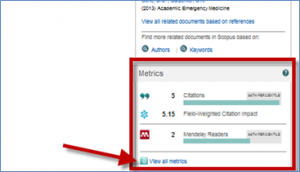Scholarly Publishing Round- up: Article Metrics
Article metrics are metrics based on usage of a scholarly work and its subsequent application. An example of a traditional article metric is a citation to a work noted in the scholarly literature which allows for in-context understanding as to the nature, purpose and motivation of the citing author/s.
With the advent of sophisticated digital applications, publishers and vendors developed other types of article metrics based on usage of the work in its digital format such as the number of times a work is read, viewed or downloaded. These are also referred to as altmetrics or alternative metrics. These metrics are generated by a variety of audiences including non-academic audiences, and are considered to be representative of the level of "public or social engagement" activity based on a work.
Examples:
- Bookmarks or Saves to online reference managers such as Mendeley
- Mentions in social network sites such as Twitter or Facebook or in Wikipedia
- Discussions in blogs and media
- Favorites or Likes in sites such as Slideshare, YouTube or Facebook
- Recommendations in sites such as Figshare
- Comments/annotations from readers in platforms such as PubMed Commons
- Noted in post-peer review resources such as F1000Prime
Tracking Article Metrics
Use the Altmetric bookmarklet to track article level metrics for your published journal articles. Drag the Bookmarklet to your browser's bookmarks bar and use this for journal articles to learn of any activity for a journal article.

Use the new Article Metrics Module in Scopus.
“By combining citation and alternative metrics, this new Article Metrics module will provide a comprehensive view of both the impact of and community engagement with an article.”
The Scopus Article Metrics includes the following metrics:
- Scholarly Activity — Downloads and posts in common research tools such as Mendeley and CiteULike
- Social Activity — Mentions characterized by rapid, brief engagement on platforms used by the public, such as Twitter, Facebook and Google+
- Scholarly Commentary — Reviews, articles and blogs by experts and scholars, such as F1000 Prime, research blogs and Wikipedia
- Mass Media — Coverage of research output in the mass media (e.g., coverage in top tier media media)
In addition to these metrics, Scopus is introducing new percentile benchmarks to show how article citations or activity compare with the averages for similar articles, taking into account:
- Date of publication
- Document type
- Disciplines associated with its source
The full metric module is available from the document details sidebar on the Scopus record page. The Metrics sidebar highlights the minimal number of meaningful metrics a researcher needs to evaluate both citation impact and levels of community engagement. Click on “View All Metrics” to be directed to the full metric module.

Readings
- We Need a Measured Approach to Metrics
- A Numbers Game: Institutions Must be Plain About Research Metrics if Academics are to Engage With Them
- Metrics: How to Handle Them Responsibly
- Impact and Attention: What Can The Metrics Tell Us?
Libguides
- Tools for Authors: Tracking Your Work
- Quantifying the Impact of My Publications: Article Metrics
